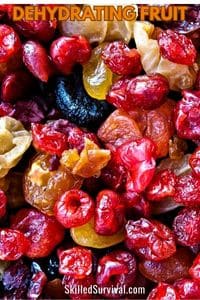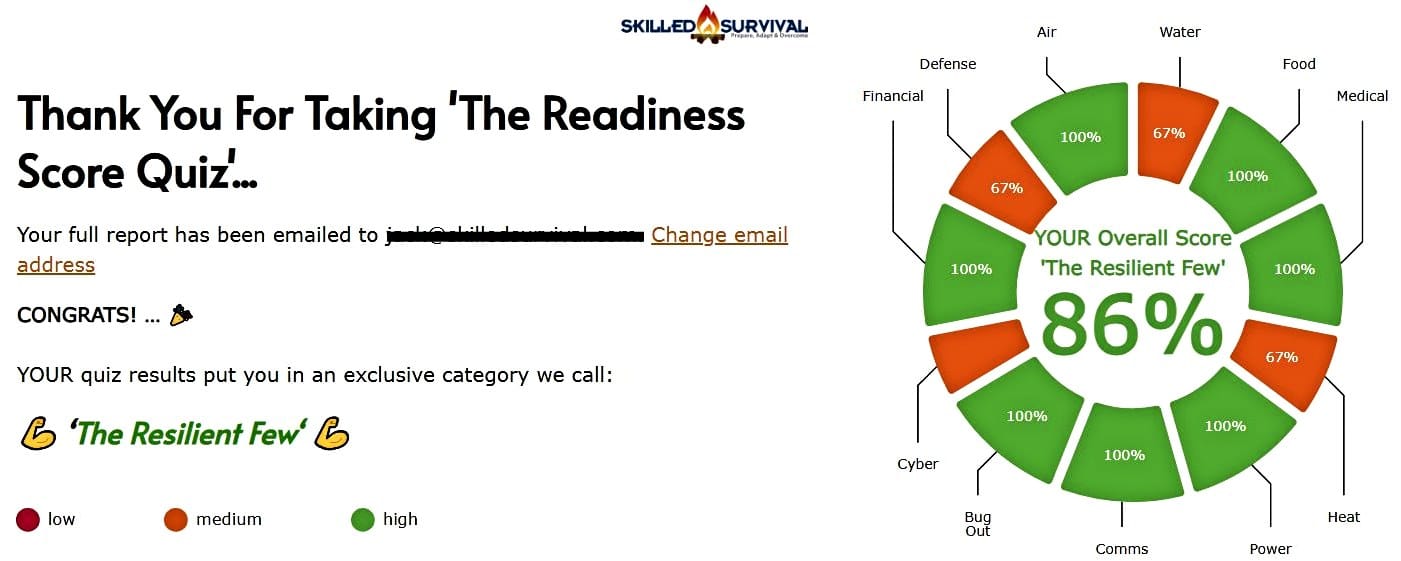
A Complete Guide To Dehydrating Fruit For Long-Term Storage & Snacks
Because dehydrating fruit is an ideal way to store some nutritious snacks without relying on your freezer.
With a good food dehydrator, and a quality vacuum sealer you can make these snacks last decades.
Fortunately, the process of dehydrating fruit is fairly straightforward:
- How To Dehydrate Fruit 101
- The Ideal Dehydrating Temperature
- It’s ALL About Proper Preparation
- How To Know When It’s Done
- A Few Extra Dehydrating Tips
- Factors That Can Affect Results
- 3 Common Dehydration Myths

Want a free family-first food planning guide?
Enter your email below to instantly download this Complete Guide PDF. No purchase necessary. 👇 👇How To Dehydrate Fruit
Ideally, dehydrating fruit should be performed during the peak season for your target fruit.
That means you’ll dehydrate different fruits at different times of the year.
For instance, oranges, strawberries, and apricots have different peak seasons.
This is good news to me, as I enjoy different peak fruits throughout the year.
↓ How To Dehydrate Fruit
The Ideal Dehydrating Temperature
A good dehydrating fruit temperature is roughly 125 – 135 degrees Fahrenheit.
Any temperature above this range will cause the skin of some fruits to become very hard or crusty.
This hardened layer then creates a barrier and prevents the insides of the fruit from drying properly.
So, it’s recommended that you remember that dehydration is a slow process.
It takes time and should not be rushed.
↓ How To Get Started Dehydrating Fruit
The Preparation Stage
Preparation is key to successful dehydration.
First, slice the fruit carefully. The thickness of the slices affects the results.
If slices are too thick, they may not achieve full dehydration, no matter how long you leave them in the dehydrator.
Plus, you will need to increase the drying time for thicker fruits.
The thinner the slices of the fruits being dried, the quicker the drying time.
Decide how thick thin you want your fruit to be; keep them as consistent as possible.
The thickness consistency of individual slices will provide uniform drying of that specific fruit piece.
Consistency between fruit slices allows the entire batch to dry evenly.
To get nearly perfect consistency, I recommend a good Madeline slicer.
A slicer such as this makes the dehydrating prep work a breeze.
Once my fruit is sliced properly, I like to run cold water over the slices for several seconds.
This helps remove any slight lumps and makes the surface a bit smoother.
You should spray the slices with lemon juice, such as apples, strawberries, and bananas.
There are two different reasons why lemon juice is sprayed:
- To prevent the fruits from ugly browning
- To avoid bacterial growth while in the drying process
Now take all the fruit slices and lay them out on the drying rack.
You don’t want any overlap (this will negatively affect the drying process).
↓ How To Pretreat Fruit For Dehydrating
When It’s Done
Now that you’ve prepped your fruit slices, it’s time to put them into your dehydrator.
Use the 125 – 135 degrees Fahrenheit temperature range and these approximate drying times to help get you started:
- Apples – 7 – 15 hours
- Bananas – 6 – 10 hours
- Cherries – 13 – 21 hours
- Cranberries – 10 – 12 hours
- Grapes – 22 – 30 hours
- Kiwi – 7 – 15 hours
- Pineapple – 10 – 18 hours
- Strawberries – 7 – 15 hours
These ranges are quite wide.
But that’s because each dehydrator, location, and fruit will differ for everyone.
↓ Recommended Dehydrating Temperatures
You can safely set it and forget it until you reach the lower end of the time range.
At that point, you’ll want to check up on the slices periodically.
So when are they “done”?
It’s a personal preference.
The dryer the fruit is, the longer it will last in storage.
So, if building your food stockpile is your main objective, then the dehydrated fruit should be drier, harder, and crisp.
If you plan to eat the fruit or add it to a party mix for the upcoming weekend, you might want to take them off when they still have a little moisture left.

Want a free family-first food planning guide?
Enter your email below to instantly download this Complete Guide PDF. No purchase necessary. 👇 👇A Few Extra Dehydrating Fruit Tips
Choose mature fruits.
They tend to have higher nutritional value and are rich in sugars.
But avoid ones that have bruises or are overripe.
Before drying fruit, you have to wash and rinse it properly.
You’ll want to remove any wax or pesticides on the fruit.
Cut the fruits into small pieces for the best results.
I recommend about 1/8 of an inch.
Expect the fruits to be pliable when done.
You can easily bend or tear it apart, but do not expect it to snap.
A Few Factors That Can Affect Results
Dehydrator Model
The model of the food dehydrator can sometimes affect the results.
Older models might not give you the outcome you prefer.
Newer models are equipped with extra features that give you more control which might improve your overall results.
Humidity
Humidity will most definitely affect your results.
High humidity will extend the drying time, while low humidity will reduce it.
Amount of fruit slices in the dehydrator
Not all dehydrators are capable of lots of fruit.
Do not be tempted to cram more slices than what your dehydrator is designed for…
Temperature
The lower the temperature, the longer it will take.
Some people recommend using a reduced temperature range of 105-110 degrees to help preserve more of the fruit’s natural nutrients and enzymes.
The Nature of the Fruit
All fruits and different varieties of fruits will dry a little bit differently.
More Than One Kind Of Fruit
Mixing and matching different fruits within the dehydrator will create unique flavors.
Give it a try.
Adding dehydrated fruit to your family’s emergency food stockpile is easy and smart.
3 Fruit Dehydration Myths
Before we jump into more tips and tricks, you have to separate fact from fiction!
Myth 1. “Dehydrating fruit destroys all the nutrients!”
Sure, dehydrating does cause some loss in nutrients like vitamin C, but truth be told, it’s no worse than cooking them on a hot skillet.
Plus, with minerals and fiber, they hang on tight even after the dehydration dance.
So don’t fret about losing all those goodies – your dried fruit still packs a punch.
Myth 2. “You need one of them fancy dehydrators to get the job done right.”
Now, don’t get me wrong, dehydrators are fine machines.
But a good oven on low heat or even the sun’s power can work magic on fruit.
It might take a tad longer, but hey, good things come to those who wait.
Myth 3. “Dehydrated fruit’s just candy in disguise, loaded with sugars.”
Sure, while drying does concentrate the natural sugars, they are still natural sugars.
You’re still getting the goodness of real fruit, minus the preservatives and unnatural sweeteners.
Remember, moderation’s the name of the game, no matter what’s in the food.
Final Thoughts
Just follow the directions, and you’ll have a nice stash of fruit for short-term or long-term survival scenarios.
I recommend you check out “Freeze Dried Food Vs Dehyrated Food” next.
Why Trust Skilled Survival...
Go here now to review a full breakdown of:
- Who We Are
- Our Credentials
- Our Mission
- & Product Recommendations...
Here are a few highlights of our teams credentials & certifications:
- Certified Member of a Mountain Search & Rescue Organization
- Plant Emergency & Safety Leader for a Major Food Manufacturer
- Member of the 10TH Mountain Division Hut Association
- Certifications: Avalanche 1, WFR, CPR
- Official Gear Tester for Numerous Outdoor Gear Companies
- Countless Multiday Backpacking trips into Remote Wilderness
- Bachelor's Degree In Mechanical Engineering
- Bachelor's Degree In Civil Engineering
- Bachelor's Degree In Biomedical Engineering
"It takes 20 years to build a reputation and five minutes to ruin it." - Warren Buffett
We're fully aware that trust is NOT something you GET but is EARNED.
And we'll continue to earn YOUR trust through our forthright and honest approach with each new Blog Post, Guide & Product we create...
Prepare, Adapt & Overcome,


AND... I've still got a few gaps in my preps...🤔 But at least, I'm not part of 'The Fragile Masses'. 👍 Find out where YOU stand by answering a few questions...

Recommended Reading
Emergency Food Storage When Calories Become Scarce
Building your emergency food storage doesn't have to be complicated. We break things down into simple steps to help you do it right.
The Most Nutritious Survival Foods You’ll Actually Love
What are the best survival foods? It depends on your goals. We look at different scenarios to help you stockpile the best emergency foods.
Unique Food Storage Ideas: The Most Surprising Locations
Want a large emergency food stockpile but living in cramped quarters? Don't let this ruin your preparedness passion! Try these unique food storage ideas.
Best Prepper Foods To Stockpile For Food Storages
What's the worst-case scenario if you choose NOT to stockpile any food? Starvation. That's why prepper foods are such a wise investment.
Valley Food Storage Review: An Expert Puts It To The Test
Unbiased and thorough Valley Food Storage review covering food supplies, packaging, taste, and shelf life. Don't buy without reading this...
Canned Food Shelf Life: A Shameless Lie For Big Profits
Are canned food shelf life expiration dates rooted in science? Here's all the proof you need to know it's a hoax in the name of profits.